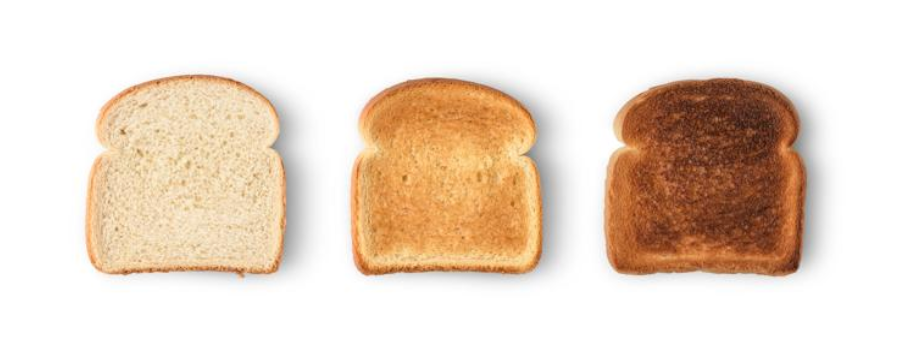From the creators of “What doesn´t kill you makes you fatter or is a sin” and “You don´t know what to eat” appears “Take care if you like overcooking!” and “Nightmare in the kitchen, there is acrylamide in your food“.
For years it was known that acrylamide was a toxic substance present in tobacco smoke and in industrial processes such as paper manufacturing, metal extraction, textile industry, colorants and other processes such as cosmetic additives or in water treatment. What nobody could imagine was that it also appears naturally when we are cooking foods such as potato crisps, French fries, biscuits and coffee.
It was first detected in foods in 2002 in Sweden when this chemical was found in starchy foods. According to experts, acrylamide is converted in the body into a chemical compound called glycidamide, which causes mutations and DNA damage that could initiate a cancerous process. The main chemical process that causes this is known as the Maillard Reaction; between sugars and amino acids (mainly one called asparagine) that are naturally present in many foods. It is the same reaction that ‘browns’ food (consequence of some pigments called melanoidins) and affects its taste and smell (due to substances such as furans). For this reason, the color could be a very practical guide for detecting acrylamide in foods.
Following, there is a summary of the evolution of the acrylamide topic according to the opinion of experts and different authorities in food safety:
International Agency for Research on Cancer (IARC): classifies it as probable carcinogens in humans (group 2A). This designation is applied when there is limited evidence of carcinogenicity in humans as well as sufficient evidence of carcinogenicity in experimental animals. For this reason, the authorities recommend that exposure to acrylamide should be as minimal as possible.
World Health Organization and Food and Agriculture Organization of the United Nations (FAO/WHO): admits that there are many doubts about the mechanism of action of acrylamide and also about the estimation of the maximum recommended intakes or how the data obtained in animals have been extrapolated to humans. They insist especially on the need for more research on topics such as the associated risks in humans, quantification of acrylamide in diets other than European ones and identify the speed of the human body to neutralize acrylamide. In 2009 FAO/WHO published a code of practice for the reduction of acrylamide in food. A large amount of information on acrylamide is located on the FAO/WHO portal ‘Acrylamide Information Network’.
European Food Safety Authority (EFSA): it is still not clear whether the consumption of this component has an effect on the risk of developing cancer in humans. In the following link you can find all the information published by the EFSA related to acrylamide since 2002. Industry (Food and Drink Europe) has developed a document called ‘toolbox’ containing measures that can be applied by the different sectors of food industry to bring its levels down.
European Commission: in November 20th, 2017 the Reglament (UE) 2017/2158 is published containing mitigation measures and benchmark levels for the reduction of the presence of acrylamide in food. The Regulation establishes mandatory mitigation measures for food companies (industry, catering and restoration). At the moment, there are only levels of reference but everything indicates that in the future they will become maximum limits.
Spanish Agency of consumption, food security and nutrition (AECOSAN): is in full campaign of information to diminish the exhibition of acrylamide among consumers and to sensitize the population on the health risks of it. The motto of the campaign: ‘Choose dorado, choose health’. In the following video and link you can find simple recommendations to control the formation of acrylamide when cooking at home.
Undoubtedly, the issue of acrylamide will continue to give much to talk about over the next few years. In CARTIF we have just launched the COLOR Project: “Acrylamide reduction in processed foods” approved in the FEDER INTERCONECTA 2018 call. In this Project, the companies GALLETAS GULLÓN, CYL IBERSNACKS and COOPERATIVA AGRÍCOLA SANTA MARTA will join efforts to achieve the following objectives:
- To reduce acrylamide in biscuit products and chips.
- To obtain olive oils capable of counteracting the formation of acrylamide in processed foods.
- To develop an indirect analytical method to quantify acrylamide more quickly, easily and economically than conventional analytical methods by measuring the COLOR of foods. In the Project we have the collaboration of the Institute of Science and Technology of Food and Nutrition (ICTAN-CSIC) and the Research Group, Food Quality and Microbiology (GRUPO CAMIALI) of the University of Extremadura.
- Waiter! One of dung beetles! - 10 February 2023
- Attention: NutriScore Traffic Light! We have a huge mess - 14 January 2021
- Acrylamide has a special ‘COLOR’ - 23 January 2019
